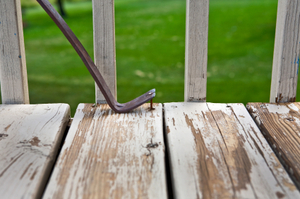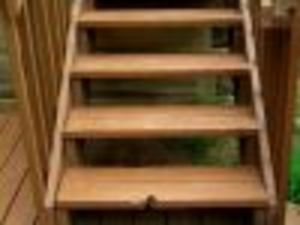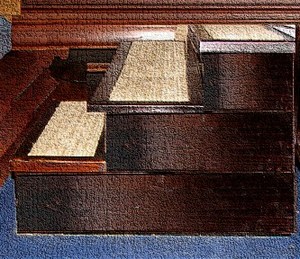The basic elements of stair building are the same indoors as out. Laying out and cutting the stringers is done in the same way; the differences are primarily in the finished appearance.
Compared to Exterior Installations
Exterior stairways are usually open and the materials used are weather resistant. Interior stairways take on a more finished look. This is mostly because they are generally, though not always, enclosed. Materials used are usually of higher quality than those used for exterior stairways, and a higher degree of finish is required. In addition, enclosed stairways usually have risers. When carpeting is to be installed as finish flooring, 1 1/8-inch plywood is often used for the risers and treads.
Some applications of exterior enclosed stairways are similar to interior installations. Where code requirements dictate weather-tight construction for exterior stairways, risers are necessary. In this case, the finished stairway will closely resemble an interior installation, although, of course, it will be more weatherproof. The design of the railings will usually differ, however.
Interior Details
If you were wise you laid temporary treads on the stair stringers during the heavy construction. Now that the messy part is over, you can install the finish treads, risers, posts, handrail, balusters, and trim.
Posts
Remove the temporary treads. Cut a hole in the subfloor large enough to allow you to attach the newel post firmly to the floor joists. It may be necessary to notch the post or add blocking. Use glue and carriage bolts or lag screws. Secure the post at the top of the stairs in the same way.
Treads and Risers
Install the finish treads and the risers, taking care to fit them snugly around the posts. Commonly, risers are mitered where they join the finished stringer. On housed stringers, butt the treads and risers tightly against the wall. On open stringers, overlap the treads but not the risers. Drive in glue-coated wedges of scrap wood underneath to hold the treads and risers in position.
Softwood tread stock commonly comes with a bullnose. If hardwood tread stock is used, a nose strip must be applied to the edge of the tread using glue and finish nails.
Handrail
There are several different ways to attach a handrail. You can use doweled butt joints, mortise-and-tenon joints, countersunk and plugged screws or bolts, or metal straps. The last method entails cutting a mortise on the underside of the handrail.
Position the handrail, but before you secure it, mark the position of each baluster. Usually, you will need two balusters per tread to meet code requirements. Mark the position of the balusters on the treads. Then drop a plumb line from the handrail. Carefully mark the position and angle of the plumb line on the rail.
If all or part of the staircase is enclosed and there is no balustrade on either side, you will have to attach a handrail to the wall. Building-supply outlets have brackets made especially for this purpose. Screw them to studs and attach the rail.
Balusters
These can be attached to the handrail either with a mortise-and-tenon joint or with dowels. To make sure that the balusters will be equidistant and plumb, drill the holes for the dowels or chisel the mortises at the marked points and at the correct angle.
Traditionally, balusters were dovetailed into the treads, and molding was used to cover the dovetailing. An easier method is to drill pilot holes at an angle and screw or toenail the balusters to the treads. When you have done this, position and attach the handrail.
Trim
Used creatively molding and quarter round can act as decorative accents while they conceal the joints. Use pieces of trim to cap a housed stringer and to finish off risers on an open one.





